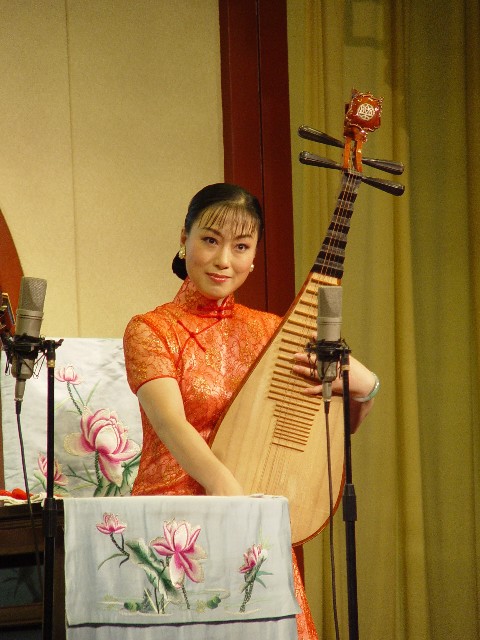| Suzhou Pingtan | ||
http://english.dbw.cn銆€銆€
2009-04-15 09:16:56
|
||
|
Photo: from baidu.com Wearing Chinese traditional dresses, two singers sit on the stage narrating various stories while accompanied by two Chinese traditional string instruments - this is a typical scene from a Pingtan performance in various teahouses and theatres found in East China's Jiangsu, Zhejiang and Shanghai. 'Pingtan' is also called 'Suzhou Pingtan', because it first originated in the city of Suzhou in Jiangsu province and is performed in the Suzhou dialect. 'Suzhou Pingtan' is a general term which includes both 'Pinghua', which is storytelling without music, and 'Tanci', which is singing in the local dialect. According to Zhou Zhenhua, vice chief of the 'Shanghai Pingtan Troupe', 'Pingtan' was developed from the ancient art of storytelling. "Suzhou Pingtan is a subgenre of Shuochang, which originated from the folk ballad, folk songs and fables which appeared over 5,000 years ago. Pinghua was developed from a speaking art called Bianwen in the Tang dynasty more than 1,300 years ago and Huaben in the Song dynasty. And Suzhou Pingtan emerged later in the Ming and early Qing dynasties when performers started to use the Suzhou dialect while performing. It has a history stretching back around 400 years." 'Pingtan' is known for its story telling, joke telling, music playing and aria singing. For 'Pinghua', there is normally only one narrator who holds a fan and a piece of wood while telling stories. And 'Tanci' is mostly performed by two singer narrators, accompanied by two Chinese traditional plucked string instruments called Sanxian and Pipa. Zhou Zhenhua says most stories 'Suzhou Pingtan' performers tell are traditional ones. "Pingtan usually performs long stories, which are divided into many parts. One part is performed over the course of a day and the whole story telling may last for weeks. There are also some stories of medium length and shorter ones. Traditional tales often follow a historical theme with heroic and epic stories." There are some 120 traditional stories left to us by the ancient performers and 'Pingtan' artists are continuously writing new ones that are closer to contemporary life. As an art with simple properties, 'Pingtan' requires its performers to be all-round developed so as to transfer the content of the stories. Gao Bowen is a 'Pingtan' actor participating in the area for over 20 years. He says 'Pingtan' artists should learn five basic skills. "Pingtan performers should firstly learn five skills including speaking, imitating, instrument playing, singing and acting. Of these, speaking is the most important. Since there are no other things assisting our performing, we should be able to fully express the attraction of the stories with our words. Besides, performers should also have knowledge about what they are talking about, such as politics, history and culture. They do not need to be very familiar with every side of life, but should know some basics." As 'Pingtan' is performed in the Suzhou dialect, it is somewhat restricted to a certain area and group of audience. However, the beautiful music with distinctive Suzhou characteristics still attracts many people in other areas of the country. There are several traditional styles of tunes and melodies which accompany 'Pingtan' performances, and performers choose different tunes to suit different stories. To innovate and attract a larger audience, some new techniques have been adopted into Pingtan performances. Zhou Zhenhua says they are continuously improving. "Sometimes we use slides or videos to show scenes which relate to the stories. For audiences in some other areas, we use subtitles to help them understand the performance. In addition, some other instruments and music are occasionally used to enrich our performance." 'Suzhou Pingtan' reached its peak time during the middle of the Qing dynasty. After the 1970s, this art gradually declined but has been rejuvenated in recent years. As most of the audiences enjoying 'Pingtan' are mainly elderly and middle aged people, organizations which promote 'Pingtan' are striving to attract more young people to this brilliant traditional art. Zhou Zhenhua says they are promoting the art to communities and schools. "We are promoting 'Pingtan' in communities where the residents can come to listen by providing tickets at very low prices. In schools and universities, we have set up some classes introducing the art to students and performing for them. What's more, we cooperate with some enterprises to introduce 'Pingtan' to their staff in their spare time as a way of entertainment." Thanks to the performances and promotion created by 'Pingtan' troupes, this fascinating art is being rejuvenated and is gaining more and more recognition among people in, and outside of, China. |
||
| Author锛? 銆€銆€銆€Source锛? CRIENGLISH.com 銆€銆€銆€ Editor锛? Wu Qiong | ||
 涓枃绠€浣?/a>銆€|銆€
涓枃绠€浣?/a>銆€|銆€











